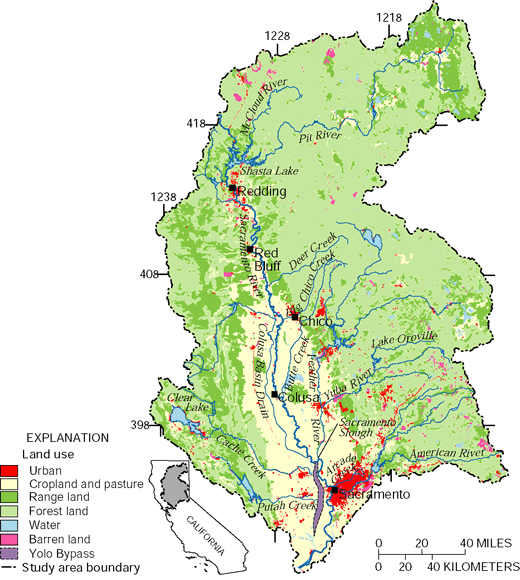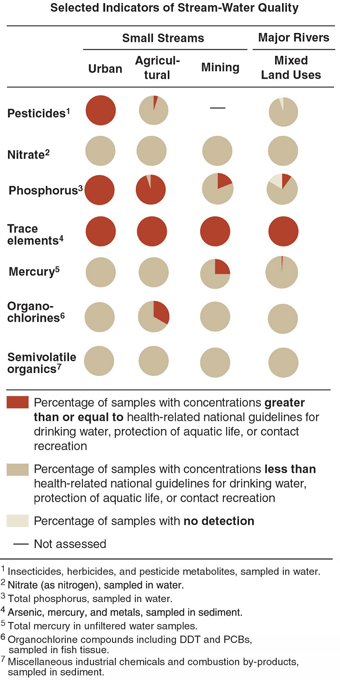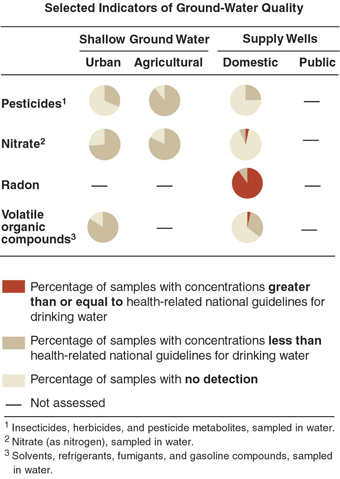SUMMARY OF MAJOR FINDINGS
The water quality of the Sacramento River and its major tributaries supports most beneficial uses most of the time, including drinking and irrigation water, recreation, and protection of fish and other aquatic life. Most of the water in the Sacramento River and its major tributaries, such as the Feather and American rivers, is derived from melting snow that enters the rivers by managed discharges of water from reservoirs. Because the snow is pure, much of the Sacramento River and its large tributaries have low concentrations of dissolved minerals. Although water quality of the Sacramento River is good most of the year, seasonal events, such as agricultural runoff or runoff from historical mining operations, may affect this quality. Variable climatic conditions and variation in amounts of rainfall, coupled with competing demands for water uses, affect the aquatic ecology of this basin. Management of the major rivers for the migration and reproduction of chinook salmon and other salmonid fish is a major concern in the Sacramento River Basin.
 |
| The Sacramento River Basin Study Unit has a wide range of land uses that encompass about 70,000 square kilometers in California. The large cropland and pasture area is known as the Sacramento Valley. The Sacramento River is the largest river in California and supplies drinking and irrigation water to communities and farms in both northern and southern California. In 1995, over 2.2 million people lived within the Study Unit boundary, with more than 1 million in the Sacramento metropolitan area. |
- Pesticides can affect the suitability of water for drinking and can also be toxic to aquatic organisms. In previous years, the concentrations of pesticides used on rice were sufficiently high to affect the health of aquatic life in streams draining the rice growing areas and to contribute to taste and odor problems for treated drinking water withdrawn from the lower Sacramento River. The concentrations of rice pesticides in agricultural streams and major rivers are now at acceptable levels.
- Organophosphate insecticides, a group of pesticides used in agricultural and urban areas, enter the Sacramento River from multiple sources at concentrations that exceed recommended criteria for protection of aquatic life. Although the concentrations in agricultural and urban streams sometimes exceed amounts that are toxic to zooplankton in laboratory tests, the toxicity is greatly reduced or eliminated when concentrations of these pesticides are diluted by the Sacramento River.
- Concentrations of E. coli bacteria exceeded USEPA criteria for moderate water-contact recreation, Phosphorus, a plant nutrient related to algal growth, was elevated in most samples collected in agricultural and urban streams.
- Mercury from historical mining activities has been a pervasive and prevalent problem of the Sacramento River Basin and downstream locations. Mercury concentrations in water exceeded recommended guidelines for the protection of aquatic life during this study.
- Salmonid fish reproduce in mountain streams, with subsequent migration to marine waters and final migration back to the mountain streams for reproduction. Water management projects (reservoirs and dams) have blocked the normal migration routes, forcing fish to move to less desirable habitats, thus affecting their reproduction.
- Optimal temperature of rivers for fish migration is maintained most of the time, but temperature management can be difficult during a drought.
- Reservoirs have affected habitats of bottom-dwelling aquatic insect populations downstream from the dams. This may affect the food supply for critical life stages of fish.
- Nonnative fish and other nonnative aquatic species have affected streams in the Sacramento Valley. Nonnative species may outcompete native species, resulting in new aquatic community assemblages, thus creating an imbalance in formerly stable ecosystems.
 |
| Major Influences on Streams and Rivers
|
Ground water of the Sacramento Valley accumulated in aquifers from precipitation in low hills surrounding the valley and from infiltration of rain, rivers, and irrigation on the valley floor. Ground water is affected by agricultural and urban land uses.
- Bentazon, a herbicide applied to rice fields, was detected in 71 percent of shallow wells sampled in the rice-growing area, despite having been suspended from use since 1989. Bentazon concentrations measured in this study did not exceed any existing drinking-water standard. To protect rivers from pesticide contamination, the rice-field water is required, by means of mechanical controls, to remain on the fields for about 1 month. During that time, pesticide levels decrease by various processes, but evaporation of the water may increase the salinity of the shallow ground water by leaving salts behind.
- Urban growth of the Sacramento metropolitan area has affected ground-water quality. Nitrate concentrations are elevated but are below drinking-water standards in most wells.
- Some of the most heavily used portion of the south-eastern Sacramento Valley aquifer was shown to generally have good water quality suitable for drinking and other uses. Only about 3 percent of the ground-water samples collected had nitrate or trichloroethene concentrations that exceeded a drinking-water standard. Radon concentrations exceeded guidelines in most of the domestic wells sampled.
 |
| Major Influences on Ground Water
|
| Table of Contents || Previous Section || Next Section || Glossary U.S. Geological Survey Circular 1215 Suggested citation:
|

